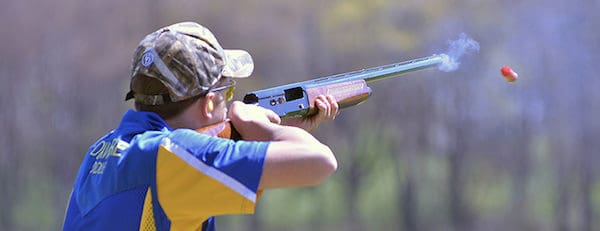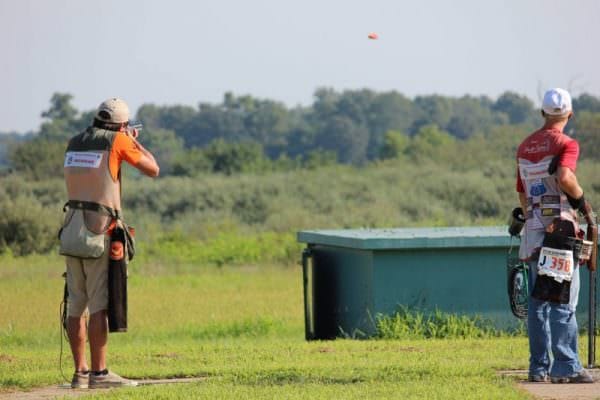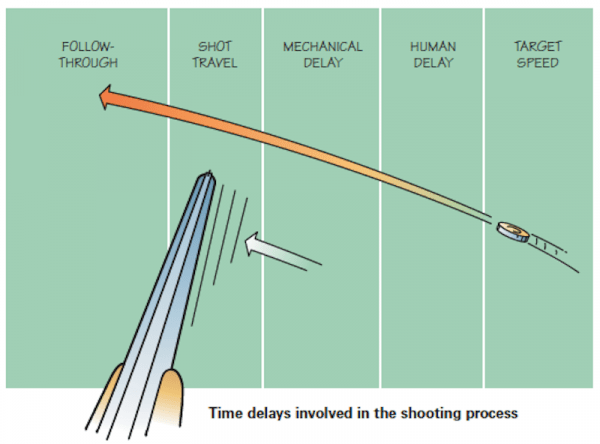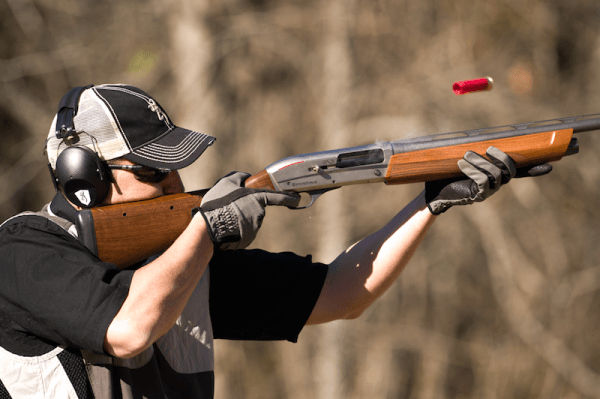
Brett Simon, NRA Lead Training Program Coordinator writes [via ammoland.com]:
If you’ve ever watched competitive shotgun shooters or hunters tracking and hitting their targets, you might think, “wow, they make it look so easy.” Like most things that are made to look effortless, there’s a lot more technique and consideration that goes into shooting moving targets. Whether shooting recreationally in a skeet field at clay targets, hunting doves in early September or shooting a 3-Gun match, the principles for shooting moving targets are the same. Learning to shoot a moving target can be very challenging due to all of the variables concerning the target’s location. We’ll begin by breaking down the eight elements of making an accurate shot.

The first element is seeing the target. Some would say “no kidding,” but it is very important that the eyes are correctly focused so that you can acquire the target quickly. For example, a skeet shooter should be looking in the direction where the target is coming from and not where it is going to be. In bird hunting, one must anticipate where the bird will come from, such as a tree line, and not look where they would like to shoot the bird.
The second element is reacting to the target. Many can react to narrowing in on a target in 0.2 seconds. This is how long it takes the brain to recognize the target and initiate movement of the firearm.

Once he or she reacts to the target they must then identify the target path and anticipate where the target will be going. Once initiating movement of the firearm, swing to the targetand establish lead. There are four types of lead:
- Sustained lead is when the shooter maintains the same amount of lead before, during and after the shot. This type of lead is used when the target path is very predictable.
- Pass through or swing through lead occurs more frequently in hunting and is characterized by starting the muzzle of the firearm behind the target and accelerating through the target until the desired lead can be reached.
- Pull-away lead is common in some of the shotgun sports. In this case the barrel or muzzle of the firearm tracks with the target and pulls away right before firing to achieve the appropriate lead.
- Intercept lead is used in practical pistol and 3-gun sports. The concept behind intercept lead is that you have a predictable point where the target is going to be. The muzzle is placed in that location and when the target appears the shot is fired.

Next, establish the correct sight picture. Doing this with a shotgun is much simpler than with a pistol or a rifle. With the shotgun, the barrel helps indicate the proper lead has been established and the trigger is pulled. With an iron sighted pistol or rifle, the sights must be aligned with each other and the proper lead must be obtained before pulling the trigger.
The final element is follow-through. This is defined as applying the fundamentals of shooting before, during and after the shot. For example, when shooting sustained lead one must continue the movement of the firearm even after the shot is fired. If one was to stop the gun too soon the lead would disappear and the shot would fall behind the target.
These eight elements all happen in a matter of seconds. Shooting moving targets is not easy but hopefully having an understanding of the processes that occur will help make you a better shooter in the field.

Want to learn more about successful shooting at moving targets? Check out this NRA Firearm Science video, in which competitive shooting champion Jessie Duff and Top Shot Season 4 champion Chris Cheng explains the fundamentals of shooting moving targets!
About Brett Simon
Brett Simon is the Lead Training Program Coordinator for NRA’s Education and Training Division. He graduated from George Mason University where he was a three-time collegiate national champion and NRA All-American as part of the school’s Trap and Skeet Team. He also competed with the Junior Olympic and National Development teams as an International Skeet shooter. Nowadays, Brett spends his spare time competing in USPSA pistol matches where he is a multiple division Master.




Nice try. It’s witchcraft and I know it.
Smoke
Mirrors
Magnets!!! It’s all magnets!!
FireClean !
Coming from a clay-shooting background, I believe shooing moving targets with clays is a better start for new shooters than shooting paper. It’s much easier to learn to point a shotgun THEN subsequently learn to aim a rifle as opposed to the other way around. From my experience instructing clay shooters, un-learning rifle techniques was a bit more of a challenge than working with a new shooter, or one that only worked with clays.
Discuss.
On some aspects, I’m inclined to agree with you.
Part of my training in defensive handgun shooting absolutely agrees with you. Bullseye pistol shooting … not as much.
In rifle shooting, esp. three position shooting, there are different physical skills involved, and controlling breathing is a very big deal.
Absolutely agreed – defensive handgun work is more akin to shotgunning; one would point, rather than aim, at a moving target.
I’ve found the best way to relate the need to focus entirely on the target to pupils is how an infant toddler is able to point at what he wants. Explaining this innate ability has proven helpful. Think about it, you can point at anything with your finger without the need to put your eyes directly behind it your whole arm, and you’re going to be dead-on that object every time.
And to your later post, yes – it’s absolutely fun ink-balling clay the instant the comb touches your face all in one, smooth motion.
“you’re going to be dead-on that object every time.”
If that was the case guns wouldn’t have sights. Just pointing will get you in the general area of your target if your target is 15 yards away, but that’s about it.
Jimmy Cirillo taught his classes that they could aim guns inside of 25 yards simply by sighting down the sides of a semi-auto.
Many of his students who had no patience for learning gun handling would do this, and get an acceptable fist-sized group at 25 yards. He told a humorous story of having taught the Panama Canal cops to shoot, and he used his “electrical tape over the rear sight” trick to get them to start grouping.
With practice, snap-pointing and adjusting with the profile of a gun can get you onto center-of-mass on a person pretty quickly. Cirillo showed us how well it worked – it made a believer out of me in a single weekend.
I just wait for it to stop moving.
Not as challenging but darn effective.
Still clays are the best.
Them’s tough to clean, but they’s good eatin’.
That’s what them $250 pocket knives are for
Shotgun skills truly are different from handgun or rifle skills. Your eyes need to stay focused on the target. The shotgun bead is something you may or may not be conscious of, but it’s never something you focus on.
So if your initial firearms training involved rifles (Focus on the front sight, damnit!) then the first thing you need to do with a shotgun is learn how to NOT look down the rim at that bead.
Oh, and if you have never tried the shotgun sports, I want you to know that blasting a clay target to powder, right out of the sky, is an absolutely therapeutic endeavor. It’s even more enjoyable than ringing steel at long range. Nothing beats a round of trap (or four) after a stressful day at work.
At some point, you internalize the leading issue. For the first several years I shot clays (sporting, trap, skeet, whatever), I’d see the target, mount the gun, lead the target, then mash down on the trigger.
At some point, I internalized the whole thing. Now I see the target, mount the gun/mash the trigger in one motion, and the clay turns to dust. As an observer, you won’t see my swing. The swing is happening as I’m mounting the gun – as soon as my cheek mounts onto the comb, I’m mashing down on the trigger and it’s over. The old hands on the trap range call this “point shooting” – you point, then shoot.
I think that most people can get to this level. If I can do this, anyone can do this, because God knows, I’m hardly a gift to any sort of athletic activity that requires coordination.
I agree. And would add that the rate of internalization varies widely with age.
My very first exposure to guns (at age 14) was my fantastic uncle taking me to his friend’s house to reload shotgun shells. After teaching me and then me cranking out 100 or so shells, they took me to a skeet club somewhere by Dearborn, Mi.
They gave me the most brief & cursory tutorial on shooting a shotgun and then put me at the first station. I popped 24 of 25 and they decided (while laughing their asses off) that it was time for lunch.
The point of my story is that internal and instinctive shooting is most quickly learned by the clear and unfettered mind. Easier to learn first than unlearn other habits from conflicting schools (types) of shooting.
PS- I think it did help that I was big for my age. 6′ at 14 y.o.
To this day I love the therapeutic value of blasting away with a good 12g.
Been a great joy to teach my son the same.
Skeet shooting: there has never been something I love so much that I’ve been so singularly poor at.
I’ve said it many times – if that clay isn’t flying straight at me or away from me, it’s getting away.
you can train a dog to retrieve whole clays.
just sayin.
A pack of Chihuahuas work good for the small pieces. That’s what I use for my burritos, not the clays, the dogs
likÈ BrÈnDĀ rÈŚponDÈD I’Μ ŚhockÈD thĀt Ā ŚtĀy Āt hoΜÈ ΜoΜ ĀblÈ to ÈĀrn $7047 in onÈ Μonth on thÈ coΜputÈr. hĀvÈ you rÈĀD thiŚ wÈb ŚitÈ
╚═► ╚═►╚═►❥❥❥❥www.planrhino.com
Comments are closed.